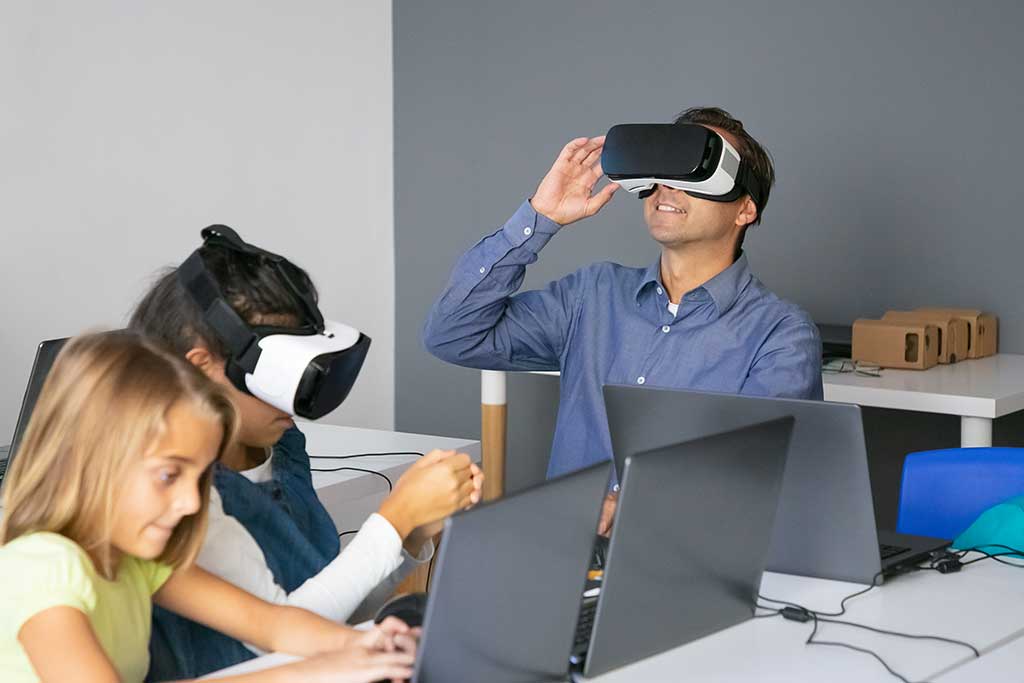Now Reading: Your Guide to Learning Technology in 2025: Simple, Smart, and Effective
-
01
Your Guide to Learning Technology in 2025: Simple, Smart, and Effective
Your Guide to Learning Technology in 2025: Simple, Smart, and Effective

The best way to learn technology in 2025 is through project-based learning. Combine video tutorials, interactive platforms, and AI tools for doubt-solving. Focus on understanding core concepts, learn by doing, and join a community for support. This practical, hands-on approach ensures effective and lasting skill development.
The world of technology is changing at a breathtaking speed. New words like Artificial Intelligence (AI), Machine Learning, and Data Science appear in the news every day. For students, working professionals, and even curious seniors in India, this can feel both exciting and overwhelming. You might ask, “With so much to learn, what is the best way to keep up?”
The good news is that the year 2025 offers more opportunities to learn technology than ever before. The “best way” is not a single path, but a smart combination of methods tailored for you. This article will guide you through a simple, effective strategy to learn any new technology with confidence.
The Big Shift: From Memorising to Applying
First, let’s understand a crucial change. In the past, learning was often about memorising facts from thick books. Today, learning technology is about application. It’s less about “what” a technology is, and more about “how” to use it to solve a real problem. Think of it like learning to drive a car—reading the manual is important, but you truly learn by getting behind the wheel.
The Smart Learner’s Toolkit for 2025
The best approach in 2025 is a mix of different learning resources. Relying on just one method is not enough anymore.
1. Start with “Why”: Choose a Project, Not Just a Topic
Before you dive into any course, ask yourself: “What do I want to build or solve?” Do you want to create a mobile app for your local community? Analyse cricket match data? Build a smart home device? Or simply make a personal website?
- Advantages:
- Purpose-Driven Learning: You learn with a clear goal, which keeps you motivated.
- Practical Skills: You encounter and solve real-world problems, which is the most effective way to learn.
- Builds a Portfolio: The projects you complete become proof of your skills for future jobs or higher education.
- Disadvantages:
- Can feel challenging at the very beginning if you are an absolute beginner.
- Requires you to break down a big project into smaller, learnable steps.
2. Learn from Video Tutorials: Your Visual Guide
Platforms like YouTube, freeCodeCamp, and Coursera are treasure chests of knowledge. In India, where visual learning is very popular, these resources are a great starting point.
- Advantages:
- Easy to Understand: Complex topics are broken down with visual examples.
- Learn at Your Pace: You can pause, rewind, and rewatch as many times as you need.
- Massive Variety: There are courses for every level, from school students to IT professionals.
- Disadvantages:
- It’s easy to get stuck in “tutorial hell”—watching videos without ever practicing yourself.
- The information can sometimes be disorganised or outdated if you don’t choose the right channel or course.
3. The Power of Interactive Platforms: Learning by Doing
This is one of the most powerful ways to learn in 2025. Websites like Khan Academy, Codecademy, and freeCodeCamp offer coding environments right inside your browser.
- Advantages:
- Instant Feedback: You write code and see the result immediately, learning from your mistakes in real-time.
- Structured Paths: They often provide a clear learning path, telling you what to learn next.
- Gamified Learning: Earning points and badges makes the process fun and engaging, especially for younger learners.
- Disadvantages:
- Sometimes, the hand-holding can be excessive, and you might not learn how to set up projects on your own computer.
- The free versions may have limited content.
4. Use AI as Your Personal Tutor, Not a Shortcut
AI tools like ChatGPT, Gemini, and Claude are revolutionising learning. You can ask them to explain a complex concept in simple terms, debug your code, or generate practice questions.
- Advantages:
- 24/7 Doubt Solver: Get instant, patient explanations for your questions at any time of day.
- Personalised Learning: Ask it to create a study plan or explain something using an example you relate to (like a cricket analogy).
- Disadvantages:
- Risk of Over-Dependence: If you just copy-paste code from AI, you will not learn. The knowledge won’t stick.
- Can Hallucinate: AI can sometimes provide incorrect or misleading information. Always double-check critical facts.
5. Join a Community: Learn with Others
Learning alone can be lonely and difficult. Being part of a community is like having a support system on your learning journey.
- How to do it:
- Join online forums like Stack Overflow for technical queries.
- Participate in local or online coding clubs and meetups.
- Form a small study group with friends or colleagues.
- Advantages:
- Get Unstuck Quickly: When you are stuck on a problem, someone in the community has likely solved it before.
- Networking: You meet people with similar interests, which can lead to job opportunities and collaborations.
- Increased Motivation: Seeing others progress inspires you to keep going.
- Disadvantages:
- It requires active participation. You can’t just be a silent observer and expect to gain much.
- Sometimes, you might encounter negative or unhelpful people, but most tech communities are very supportive.
Building the Right Mindset for 2025
Your attitude is more important than any resource you use.
1. Embrace Lifelong Learning
Forget the idea that learning ends after school or college. Technology evolves constantly. The goal is to become a lifelong learner—someone who is always curious and willing to update their skills.
2. Don’t Fear Failure, Learn from It
You will get errors in your code. Your projects will sometimes fail. This is not a sign that you are bad at technology; it is an essential part of the process. Every error message is a clue that helps you learn. Develop a “debugging” mindset.
3. Focus on Concepts, Not Just Syntax
It’s easy to get worried about memorising the exact code (syntax) for a programming language. While this is important, understanding the core concept is far more valuable. For example, once you understand the concept of a “loop,” you can apply it in any programming language. Concepts last a lifetime; tools change.
A Simple Action Plan to Start Today
- Pick One Thing: Don’t try to learn AI, web development, and cybersecurity all at once. Choose one small area that interests you. For example, “I will learn to build a basic website using HTML and CSS.”
- Find a “Project-Based” Course: Search on YouTube or Coursera for “Build a simple website project for beginners.”
- Code Along: Don’t just watch the video. Code along with the instructor. This builds muscle memory.
- Break and Remix: After finishing the tutorial, try to change the code. Change the colours, add a new button, or modify the text. This is where real learning begins.
- Join a Community: Share your small project on a platform like LinkedIn or a coding forum. Ask for feedback.
Advantages and Disadvantages of the Modern Learning Approach
Overall Advantages:
- Highly Accessible: Most resources are low-cost or free, breaking down financial barriers.
- Flexible: You can learn from anywhere, at any time that suits your schedule.
- Relevant and Updated: Online content is updated much faster than traditional textbooks.
- Empowering: It gives you the power to take control of your own learning and career path.
Overall Challenges:
- Information Overload: The vast amount of choice can be paralyzing. The key is to pick one good resource and stick with it.
- Self-Discipline Required: Without a fixed classroom schedule, you need to be motivated and disciplined to make consistent progress.
- Digital Divide: Access to a stable internet connection and a computer is still a challenge in some parts of India, though smartphone penetration is helping bridge this gap.
Conclusion: You Can Do It!
The best way to learn technology in 2025 is to be an active, project-driven learner who uses a mix of videos, interactive platforms, AI tools, and community support. Remember, every expert was once a beginner who did not give up. Start small, be consistent, and don’t be afraid to make mistakes. Your journey to mastering technology starts with a single step.
Stay Informed With the Latest & Most Important News
Previous Post
Next Post
-
 01Does Free Money Exist? The Real Story of How Your Passive Income Gets Taxed in India
01Does Free Money Exist? The Real Story of How Your Passive Income Gets Taxed in India -
 02Your Journey to Financial Freedom: A Simple Guide to Building Passive Income in India
02Your Journey to Financial Freedom: A Simple Guide to Building Passive Income in India -
 03Beyond the First Rupee: Building Your Personal System for Passive Income Success in India
03Beyond the First Rupee: Building Your Personal System for Passive Income Success in India -
 04Your Extra Income Journey: Top Side Hustles to Boost Your Earnings in India
04Your Extra Income Journey: Top Side Hustles to Boost Your Earnings in India -
 05The Right Way for Kids to Learn Technology: A Guide for Indian Parents
05The Right Way for Kids to Learn Technology: A Guide for Indian Parents -
 06A New World at Your Fingertips: A Simple Guide to Technology Tutorials for Seniors
06A New World at Your Fingertips: A Simple Guide to Technology Tutorials for Seniors -
 07Your Guide to Learning Technology in 2025: Simple, Smart, and Effective
07Your Guide to Learning Technology in 2025: Simple, Smart, and Effective































